Business Consulting Report: LSST & Fairfield Institute Analysis, BM561
VerifiedAdded on 2022/11/28
|10
|2093
|211
Report
AI Summary
This business consulting report provides an in-depth analysis of the challenges faced by LSST and Fairfield Institute of Management within the higher education sector. It begins with an introduction and problem statements, followed by a comprehensive industry analysis, including competition, target customers, marketing strategies, and external factors impacting the clients. The report identifies the top three client issues, such as rising competition, recruitment challenges, and workforce retention. The report also employs Porter's Five Forces framework to evaluate the competitive landscape. The report concludes with strategic recommendations and a conclusion aimed at helping the clients overcome these challenges and achieve their goals. The report also includes the references used to support the analysis.

BM561 - Business
Consulting
Business Report
Consulting
Business Report
Paraphrase This Document
Need a fresh take? Get an instant paraphrase of this document with our AI Paraphraser
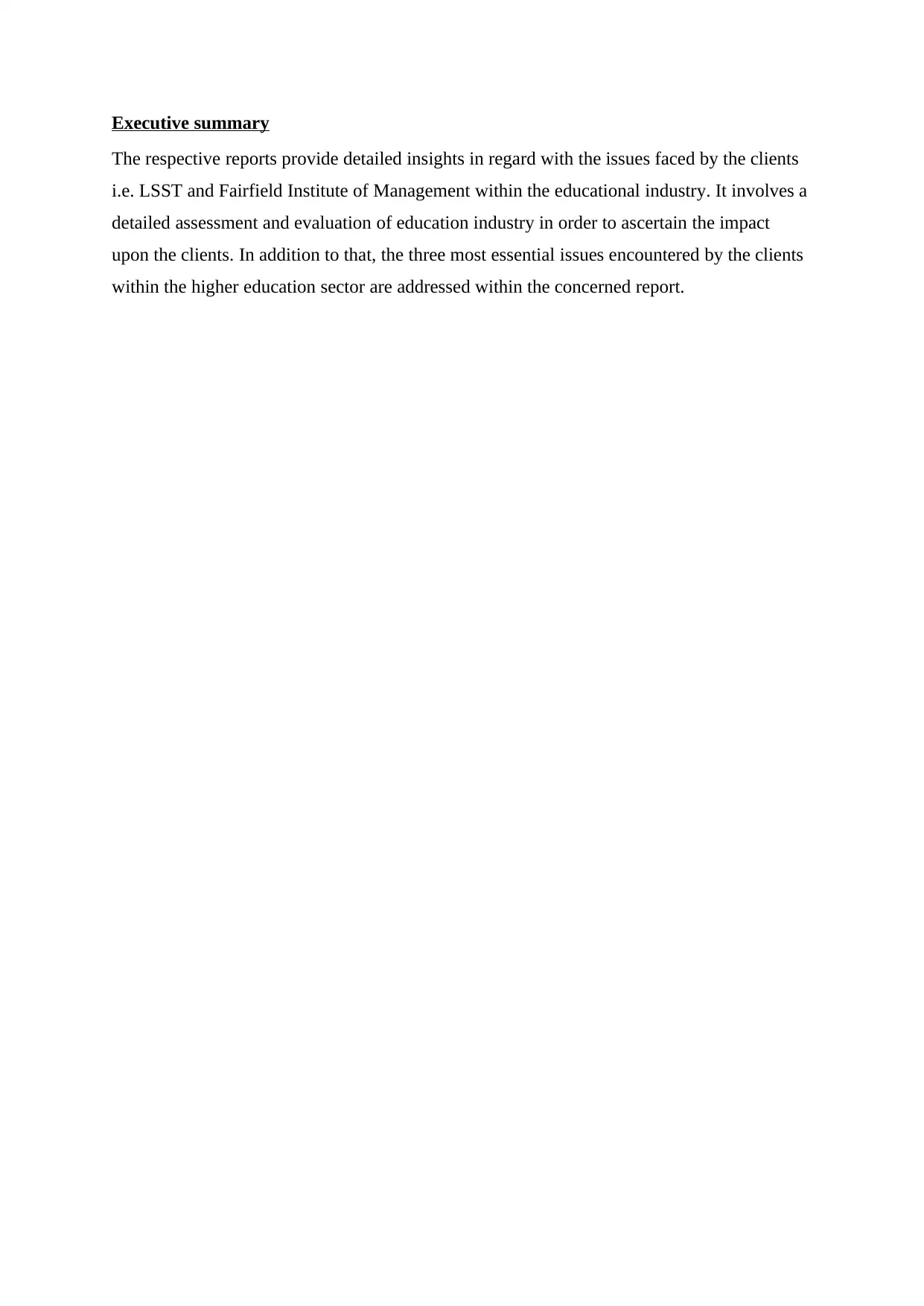
Executive summary
The respective reports provide detailed insights in regard with the issues faced by the clients
i.e. LSST and Fairfield Institute of Management within the educational industry. It involves a
detailed assessment and evaluation of education industry in order to ascertain the impact
upon the clients. In addition to that, the three most essential issues encountered by the clients
within the higher education sector are addressed within the concerned report.
The respective reports provide detailed insights in regard with the issues faced by the clients
i.e. LSST and Fairfield Institute of Management within the educational industry. It involves a
detailed assessment and evaluation of education industry in order to ascertain the impact
upon the clients. In addition to that, the three most essential issues encountered by the clients
within the higher education sector are addressed within the concerned report.
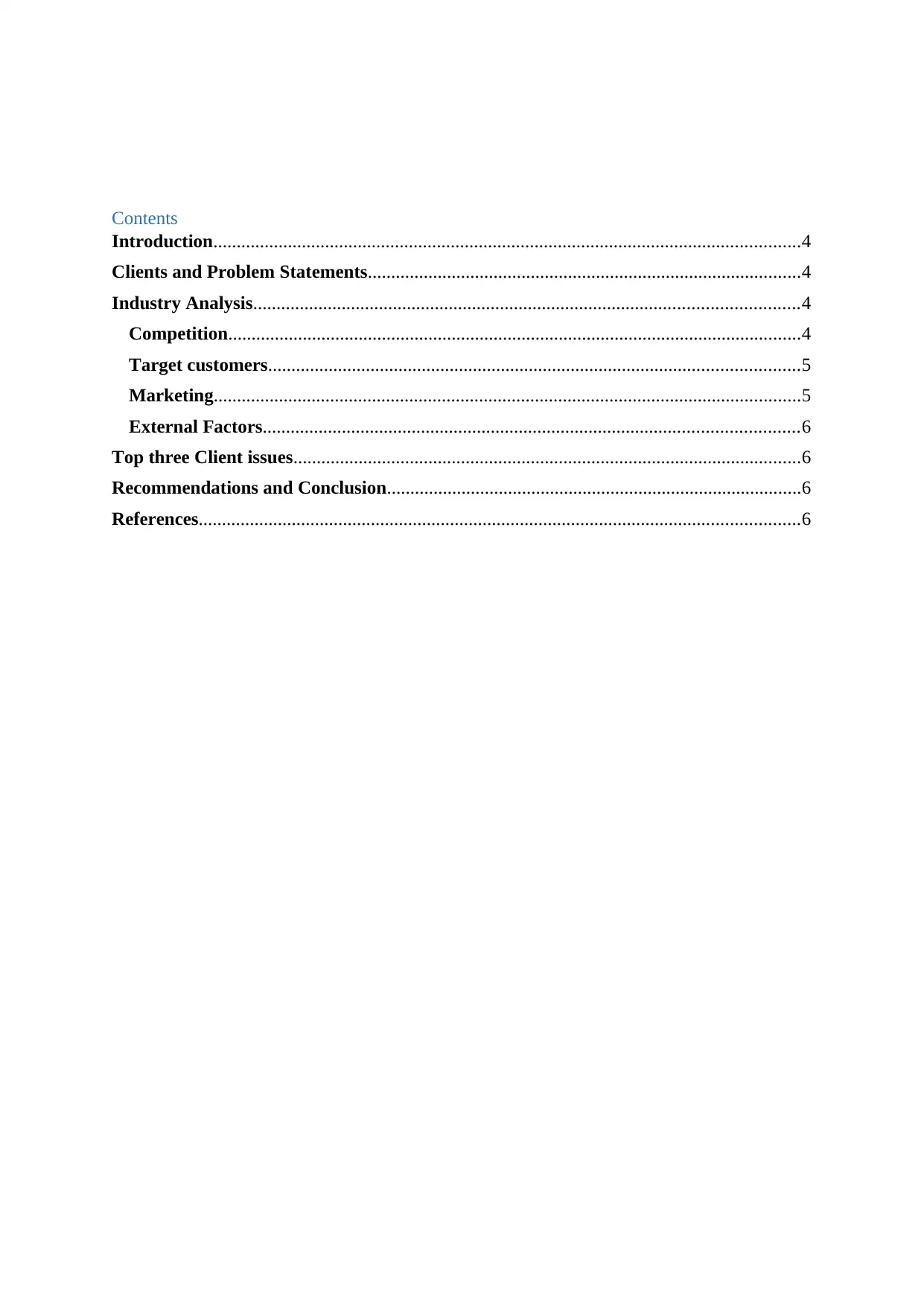
Contents
Introduction..............................................................................................................................4
Clients and Problem Statements.............................................................................................4
Industry Analysis.....................................................................................................................4
Competition...........................................................................................................................4
Target customers..................................................................................................................5
Marketing..............................................................................................................................5
External Factors...................................................................................................................6
Top three Client issues.............................................................................................................6
Recommendations and Conclusion.........................................................................................6
References.................................................................................................................................6
Introduction..............................................................................................................................4
Clients and Problem Statements.............................................................................................4
Industry Analysis.....................................................................................................................4
Competition...........................................................................................................................4
Target customers..................................................................................................................5
Marketing..............................................................................................................................5
External Factors...................................................................................................................6
Top three Client issues.............................................................................................................6
Recommendations and Conclusion.........................................................................................6
References.................................................................................................................................6
⊘ This is a preview!⊘
Do you want full access?
Subscribe today to unlock all pages.

Trusted by 1+ million students worldwide
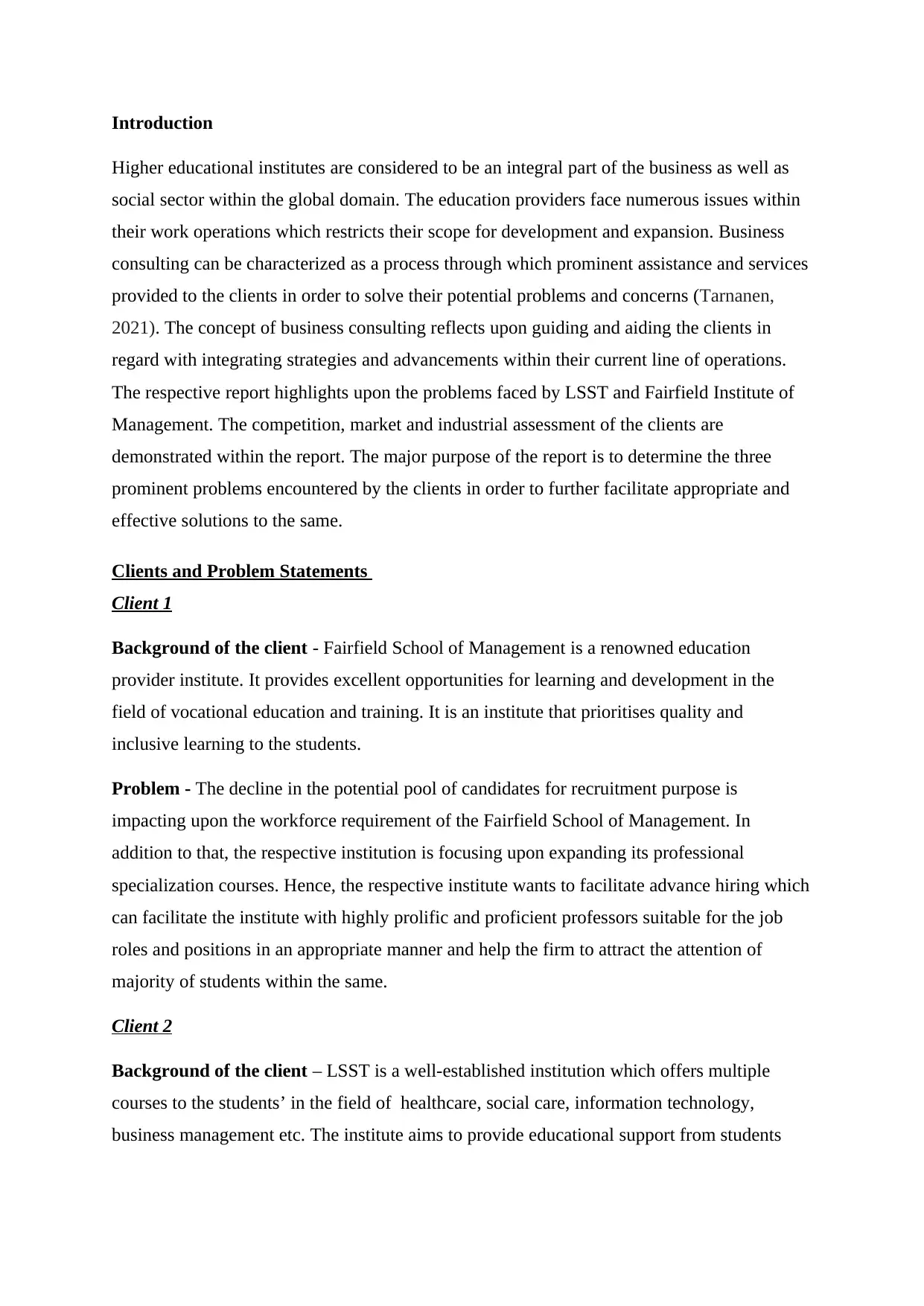
Introduction
Higher educational institutes are considered to be an integral part of the business as well as
social sector within the global domain. The education providers face numerous issues within
their work operations which restricts their scope for development and expansion. Business
consulting can be characterized as a process through which prominent assistance and services
provided to the clients in order to solve their potential problems and concerns (Tarnanen,
2021). The concept of business consulting reflects upon guiding and aiding the clients in
regard with integrating strategies and advancements within their current line of operations.
The respective report highlights upon the problems faced by LSST and Fairfield Institute of
Management. The competition, market and industrial assessment of the clients are
demonstrated within the report. The major purpose of the report is to determine the three
prominent problems encountered by the clients in order to further facilitate appropriate and
effective solutions to the same.
Clients and Problem Statements
Client 1
Background of the client - Fairfield School of Management is a renowned education
provider institute. It provides excellent opportunities for learning and development in the
field of vocational education and training. It is an institute that prioritises quality and
inclusive learning to the students.
Problem - The decline in the potential pool of candidates for recruitment purpose is
impacting upon the workforce requirement of the Fairfield School of Management. In
addition to that, the respective institution is focusing upon expanding its professional
specialization courses. Hence, the respective institute wants to facilitate advance hiring which
can facilitate the institute with highly prolific and proficient professors suitable for the job
roles and positions in an appropriate manner and help the firm to attract the attention of
majority of students within the same.
Client 2
Background of the client – LSST is a well-established institution which offers multiple
courses to the students’ in the field of healthcare, social care, information technology,
business management etc. The institute aims to provide educational support from students
Higher educational institutes are considered to be an integral part of the business as well as
social sector within the global domain. The education providers face numerous issues within
their work operations which restricts their scope for development and expansion. Business
consulting can be characterized as a process through which prominent assistance and services
provided to the clients in order to solve their potential problems and concerns (Tarnanen,
2021). The concept of business consulting reflects upon guiding and aiding the clients in
regard with integrating strategies and advancements within their current line of operations.
The respective report highlights upon the problems faced by LSST and Fairfield Institute of
Management. The competition, market and industrial assessment of the clients are
demonstrated within the report. The major purpose of the report is to determine the three
prominent problems encountered by the clients in order to further facilitate appropriate and
effective solutions to the same.
Clients and Problem Statements
Client 1
Background of the client - Fairfield School of Management is a renowned education
provider institute. It provides excellent opportunities for learning and development in the
field of vocational education and training. It is an institute that prioritises quality and
inclusive learning to the students.
Problem - The decline in the potential pool of candidates for recruitment purpose is
impacting upon the workforce requirement of the Fairfield School of Management. In
addition to that, the respective institution is focusing upon expanding its professional
specialization courses. Hence, the respective institute wants to facilitate advance hiring which
can facilitate the institute with highly prolific and proficient professors suitable for the job
roles and positions in an appropriate manner and help the firm to attract the attention of
majority of students within the same.
Client 2
Background of the client – LSST is a well-established institution which offers multiple
courses to the students’ in the field of healthcare, social care, information technology,
business management etc. The institute aims to provide educational support from students
Paraphrase This Document
Need a fresh take? Get an instant paraphrase of this document with our AI Paraphraser
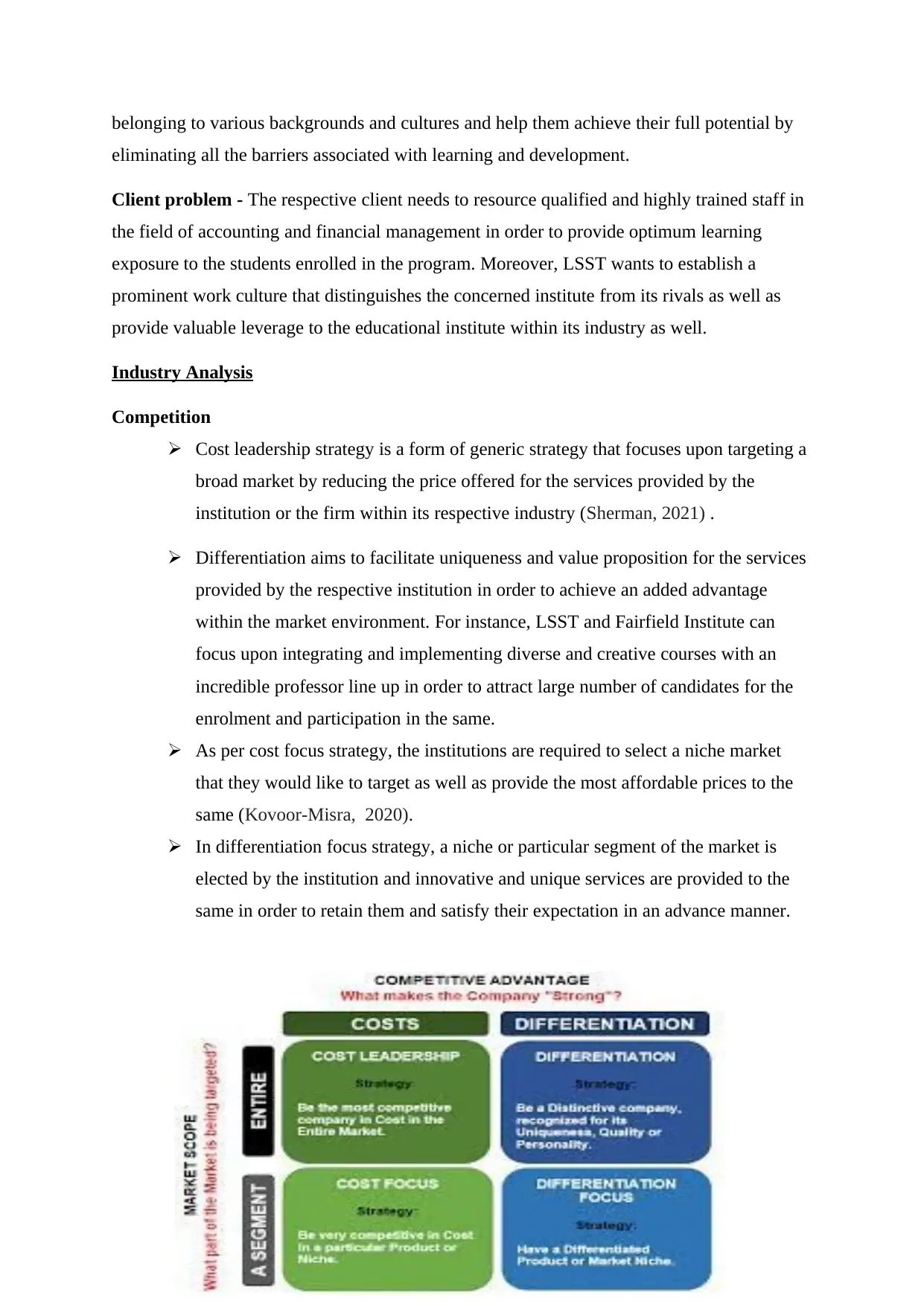
belonging to various backgrounds and cultures and help them achieve their full potential by
eliminating all the barriers associated with learning and development.
Client problem - The respective client needs to resource qualified and highly trained staff in
the field of accounting and financial management in order to provide optimum learning
exposure to the students enrolled in the program. Moreover, LSST wants to establish a
prominent work culture that distinguishes the concerned institute from its rivals as well as
provide valuable leverage to the educational institute within its industry as well.
Industry Analysis
Competition
Cost leadership strategy is a form of generic strategy that focuses upon targeting a
broad market by reducing the price offered for the services provided by the
institution or the firm within its respective industry (Sherman, 2021) .
Differentiation aims to facilitate uniqueness and value proposition for the services
provided by the respective institution in order to achieve an added advantage
within the market environment. For instance, LSST and Fairfield Institute can
focus upon integrating and implementing diverse and creative courses with an
incredible professor line up in order to attract large number of candidates for the
enrolment and participation in the same.
As per cost focus strategy, the institutions are required to select a niche market
that they would like to target as well as provide the most affordable prices to the
same (Kovoor-Misra, 2020).
In differentiation focus strategy, a niche or particular segment of the market is
elected by the institution and innovative and unique services are provided to the
same in order to retain them and satisfy their expectation in an advance manner.
eliminating all the barriers associated with learning and development.
Client problem - The respective client needs to resource qualified and highly trained staff in
the field of accounting and financial management in order to provide optimum learning
exposure to the students enrolled in the program. Moreover, LSST wants to establish a
prominent work culture that distinguishes the concerned institute from its rivals as well as
provide valuable leverage to the educational institute within its industry as well.
Industry Analysis
Competition
Cost leadership strategy is a form of generic strategy that focuses upon targeting a
broad market by reducing the price offered for the services provided by the
institution or the firm within its respective industry (Sherman, 2021) .
Differentiation aims to facilitate uniqueness and value proposition for the services
provided by the respective institution in order to achieve an added advantage
within the market environment. For instance, LSST and Fairfield Institute can
focus upon integrating and implementing diverse and creative courses with an
incredible professor line up in order to attract large number of candidates for the
enrolment and participation in the same.
As per cost focus strategy, the institutions are required to select a niche market
that they would like to target as well as provide the most affordable prices to the
same (Kovoor-Misra, 2020).
In differentiation focus strategy, a niche or particular segment of the market is
elected by the institution and innovative and unique services are provided to the
same in order to retain them and satisfy their expectation in an advance manner.
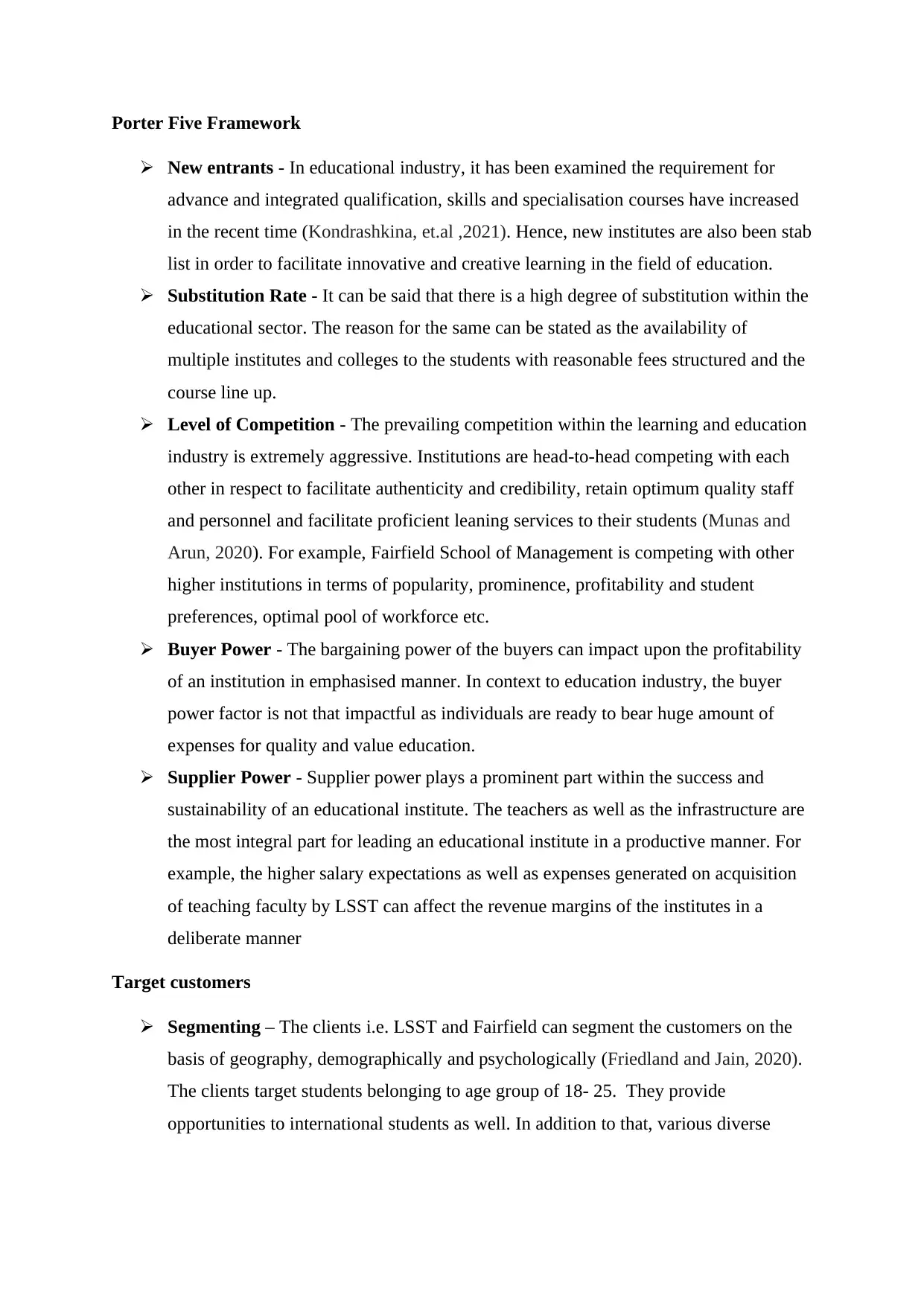
Porter Five Framework
New entrants - In educational industry, it has been examined the requirement for
advance and integrated qualification, skills and specialisation courses have increased
in the recent time (Kondrashkina, et.al ,2021). Hence, new institutes are also been stab
list in order to facilitate innovative and creative learning in the field of education.
Substitution Rate - It can be said that there is a high degree of substitution within the
educational sector. The reason for the same can be stated as the availability of
multiple institutes and colleges to the students with reasonable fees structured and the
course line up.
Level of Competition - The prevailing competition within the learning and education
industry is extremely aggressive. Institutions are head-to-head competing with each
other in respect to facilitate authenticity and credibility, retain optimum quality staff
and personnel and facilitate proficient leaning services to their students (Munas and
Arun, 2020). For example, Fairfield School of Management is competing with other
higher institutions in terms of popularity, prominence, profitability and student
preferences, optimal pool of workforce etc.
Buyer Power - The bargaining power of the buyers can impact upon the profitability
of an institution in emphasised manner. In context to education industry, the buyer
power factor is not that impactful as individuals are ready to bear huge amount of
expenses for quality and value education.
Supplier Power - Supplier power plays a prominent part within the success and
sustainability of an educational institute. The teachers as well as the infrastructure are
the most integral part for leading an educational institute in a productive manner. For
example, the higher salary expectations as well as expenses generated on acquisition
of teaching faculty by LSST can affect the revenue margins of the institutes in a
deliberate manner
Target customers
Segmenting – The clients i.e. LSST and Fairfield can segment the customers on the
basis of geography, demographically and psychologically (Friedland and Jain, 2020).
The clients target students belonging to age group of 18- 25. They provide
opportunities to international students as well. In addition to that, various diverse
New entrants - In educational industry, it has been examined the requirement for
advance and integrated qualification, skills and specialisation courses have increased
in the recent time (Kondrashkina, et.al ,2021). Hence, new institutes are also been stab
list in order to facilitate innovative and creative learning in the field of education.
Substitution Rate - It can be said that there is a high degree of substitution within the
educational sector. The reason for the same can be stated as the availability of
multiple institutes and colleges to the students with reasonable fees structured and the
course line up.
Level of Competition - The prevailing competition within the learning and education
industry is extremely aggressive. Institutions are head-to-head competing with each
other in respect to facilitate authenticity and credibility, retain optimum quality staff
and personnel and facilitate proficient leaning services to their students (Munas and
Arun, 2020). For example, Fairfield School of Management is competing with other
higher institutions in terms of popularity, prominence, profitability and student
preferences, optimal pool of workforce etc.
Buyer Power - The bargaining power of the buyers can impact upon the profitability
of an institution in emphasised manner. In context to education industry, the buyer
power factor is not that impactful as individuals are ready to bear huge amount of
expenses for quality and value education.
Supplier Power - Supplier power plays a prominent part within the success and
sustainability of an educational institute. The teachers as well as the infrastructure are
the most integral part for leading an educational institute in a productive manner. For
example, the higher salary expectations as well as expenses generated on acquisition
of teaching faculty by LSST can affect the revenue margins of the institutes in a
deliberate manner
Target customers
Segmenting – The clients i.e. LSST and Fairfield can segment the customers on the
basis of geography, demographically and psychologically (Friedland and Jain, 2020).
The clients target students belonging to age group of 18- 25. They provide
opportunities to international students as well. In addition to that, various diverse
⊘ This is a preview!⊘
Do you want full access?
Subscribe today to unlock all pages.

Trusted by 1+ million students worldwide

courses are offered by the clients as per the choices, preferences, values and interest
of the students.
Targeting – In order to target the segments, the clients rely upon prominent
marketing programmes and campaigns through which they can persuade the customer
to invest into the educational services in enhanced manner.
Positioning - The clients opt for various marketing tactics in order to position
themselves within the industry such as word of mouth, online advertisements, review
analytics etc.
Marketing
Marketing can be defined as a tool that can help institutions to create demand for their
services within their respective industry domain. It helps to create awareness about
the institutional policy and attract the customers to words the same in order to amplify
the success and profitability of the institution in the long run (James, Humez and
Laufenberg, 2020).
There are numerous techniques and mechanisms that can be capitalised by the clients
in order to market their services such as digital advertising, optimising on social
media platforms, interactive portals and websites, review platforms etc.
In the current era, the trend of digitalisation has also integrated within the education
industry. The clients can utilise digital strategies such as content marketing, email
marketing, social media marketing, search engine optimisation etc. in order to reach
global audience and communicate their vision to the same in an advance and effective
manner.
of the students.
Targeting – In order to target the segments, the clients rely upon prominent
marketing programmes and campaigns through which they can persuade the customer
to invest into the educational services in enhanced manner.
Positioning - The clients opt for various marketing tactics in order to position
themselves within the industry such as word of mouth, online advertisements, review
analytics etc.
Marketing
Marketing can be defined as a tool that can help institutions to create demand for their
services within their respective industry domain. It helps to create awareness about
the institutional policy and attract the customers to words the same in order to amplify
the success and profitability of the institution in the long run (James, Humez and
Laufenberg, 2020).
There are numerous techniques and mechanisms that can be capitalised by the clients
in order to market their services such as digital advertising, optimising on social
media platforms, interactive portals and websites, review platforms etc.
In the current era, the trend of digitalisation has also integrated within the education
industry. The clients can utilise digital strategies such as content marketing, email
marketing, social media marketing, search engine optimisation etc. in order to reach
global audience and communicate their vision to the same in an advance and effective
manner.
Paraphrase This Document
Need a fresh take? Get an instant paraphrase of this document with our AI Paraphraser
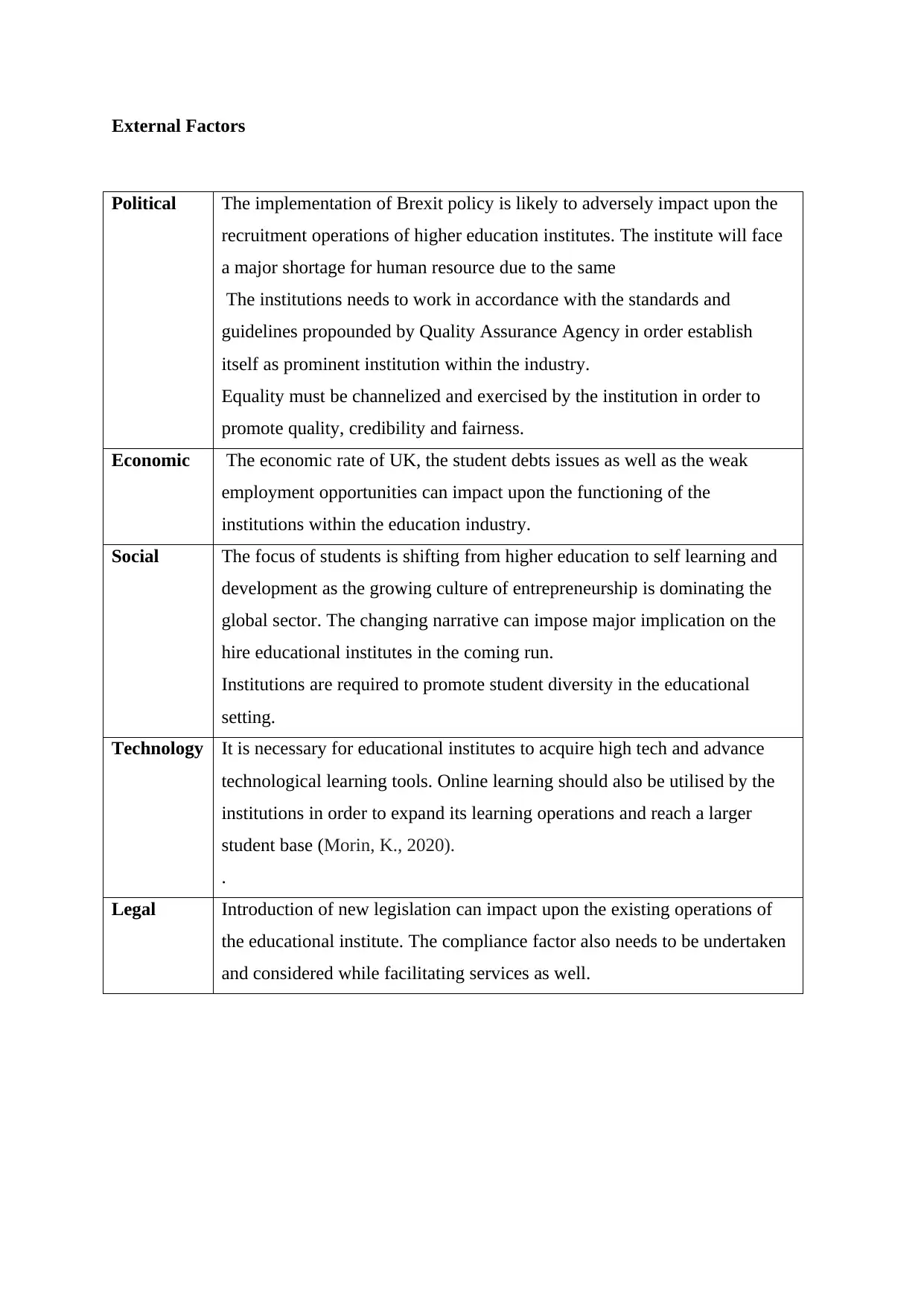
External Factors
Political The implementation of Brexit policy is likely to adversely impact upon the
recruitment operations of higher education institutes. The institute will face
a major shortage for human resource due to the same
The institutions needs to work in accordance with the standards and
guidelines propounded by Quality Assurance Agency in order establish
itself as prominent institution within the industry.
Equality must be channelized and exercised by the institution in order to
promote quality, credibility and fairness.
Economic The economic rate of UK, the student debts issues as well as the weak
employment opportunities can impact upon the functioning of the
institutions within the education industry.
Social The focus of students is shifting from higher education to self learning and
development as the growing culture of entrepreneurship is dominating the
global sector. The changing narrative can impose major implication on the
hire educational institutes in the coming run.
Institutions are required to promote student diversity in the educational
setting.
Technology It is necessary for educational institutes to acquire high tech and advance
technological learning tools. Online learning should also be utilised by the
institutions in order to expand its learning operations and reach a larger
student base (Morin, K., 2020).
.
Legal Introduction of new legislation can impact upon the existing operations of
the educational institute. The compliance factor also needs to be undertaken
and considered while facilitating services as well.
Political The implementation of Brexit policy is likely to adversely impact upon the
recruitment operations of higher education institutes. The institute will face
a major shortage for human resource due to the same
The institutions needs to work in accordance with the standards and
guidelines propounded by Quality Assurance Agency in order establish
itself as prominent institution within the industry.
Equality must be channelized and exercised by the institution in order to
promote quality, credibility and fairness.
Economic The economic rate of UK, the student debts issues as well as the weak
employment opportunities can impact upon the functioning of the
institutions within the education industry.
Social The focus of students is shifting from higher education to self learning and
development as the growing culture of entrepreneurship is dominating the
global sector. The changing narrative can impose major implication on the
hire educational institutes in the coming run.
Institutions are required to promote student diversity in the educational
setting.
Technology It is necessary for educational institutes to acquire high tech and advance
technological learning tools. Online learning should also be utilised by the
institutions in order to expand its learning operations and reach a larger
student base (Morin, K., 2020).
.
Legal Introduction of new legislation can impact upon the existing operations of
the educational institute. The compliance factor also needs to be undertaken
and considered while facilitating services as well.
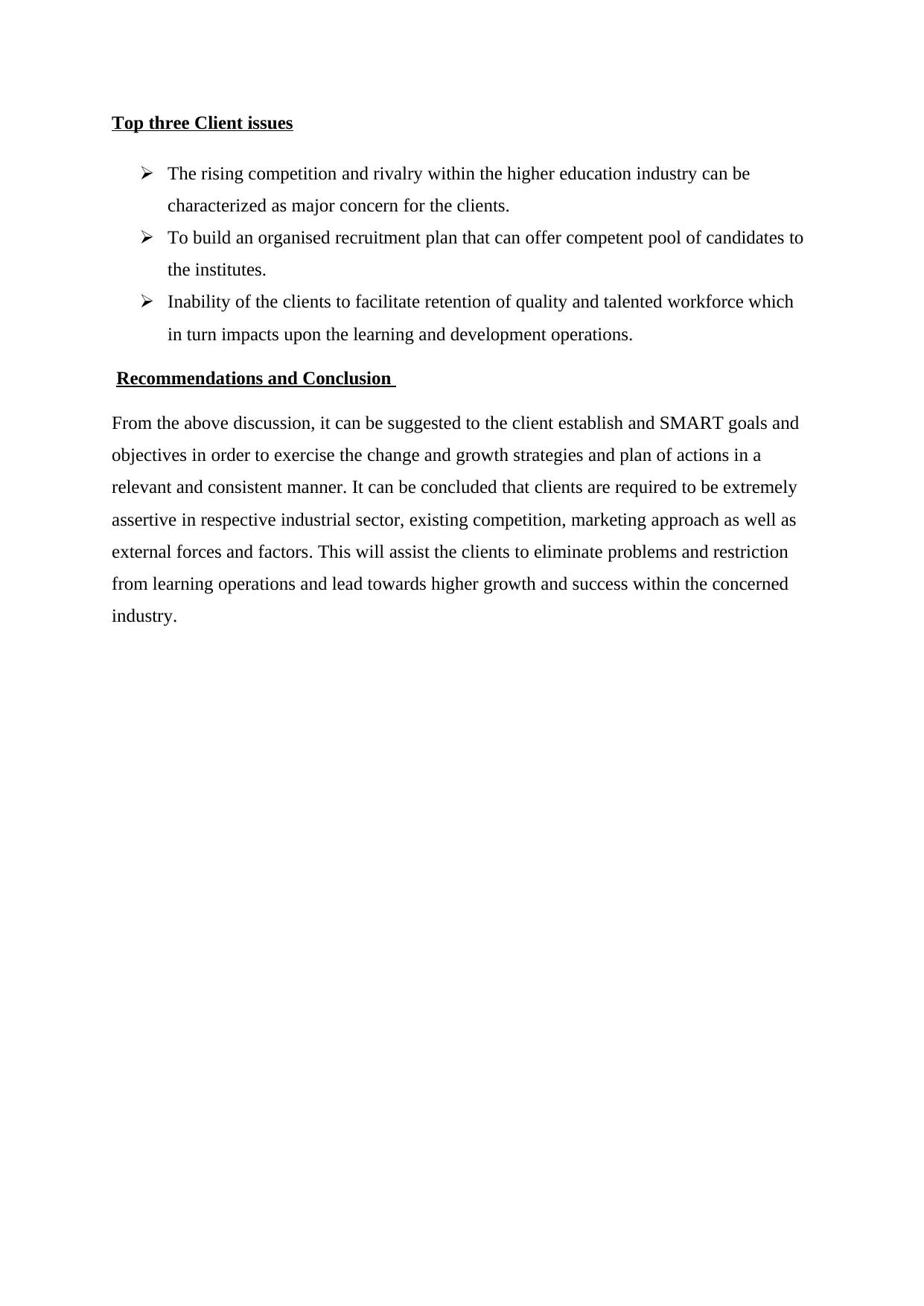
Top three Client issues
The rising competition and rivalry within the higher education industry can be
characterized as major concern for the clients.
To build an organised recruitment plan that can offer competent pool of candidates to
the institutes.
Inability of the clients to facilitate retention of quality and talented workforce which
in turn impacts upon the learning and development operations.
Recommendations and Conclusion
From the above discussion, it can be suggested to the client establish and SMART goals and
objectives in order to exercise the change and growth strategies and plan of actions in a
relevant and consistent manner. It can be concluded that clients are required to be extremely
assertive in respective industrial sector, existing competition, marketing approach as well as
external forces and factors. This will assist the clients to eliminate problems and restriction
from learning operations and lead towards higher growth and success within the concerned
industry.
The rising competition and rivalry within the higher education industry can be
characterized as major concern for the clients.
To build an organised recruitment plan that can offer competent pool of candidates to
the institutes.
Inability of the clients to facilitate retention of quality and talented workforce which
in turn impacts upon the learning and development operations.
Recommendations and Conclusion
From the above discussion, it can be suggested to the client establish and SMART goals and
objectives in order to exercise the change and growth strategies and plan of actions in a
relevant and consistent manner. It can be concluded that clients are required to be extremely
assertive in respective industrial sector, existing competition, marketing approach as well as
external forces and factors. This will assist the clients to eliminate problems and restriction
from learning operations and lead towards higher growth and success within the concerned
industry.
⊘ This is a preview!⊘
Do you want full access?
Subscribe today to unlock all pages.

Trusted by 1+ million students worldwide
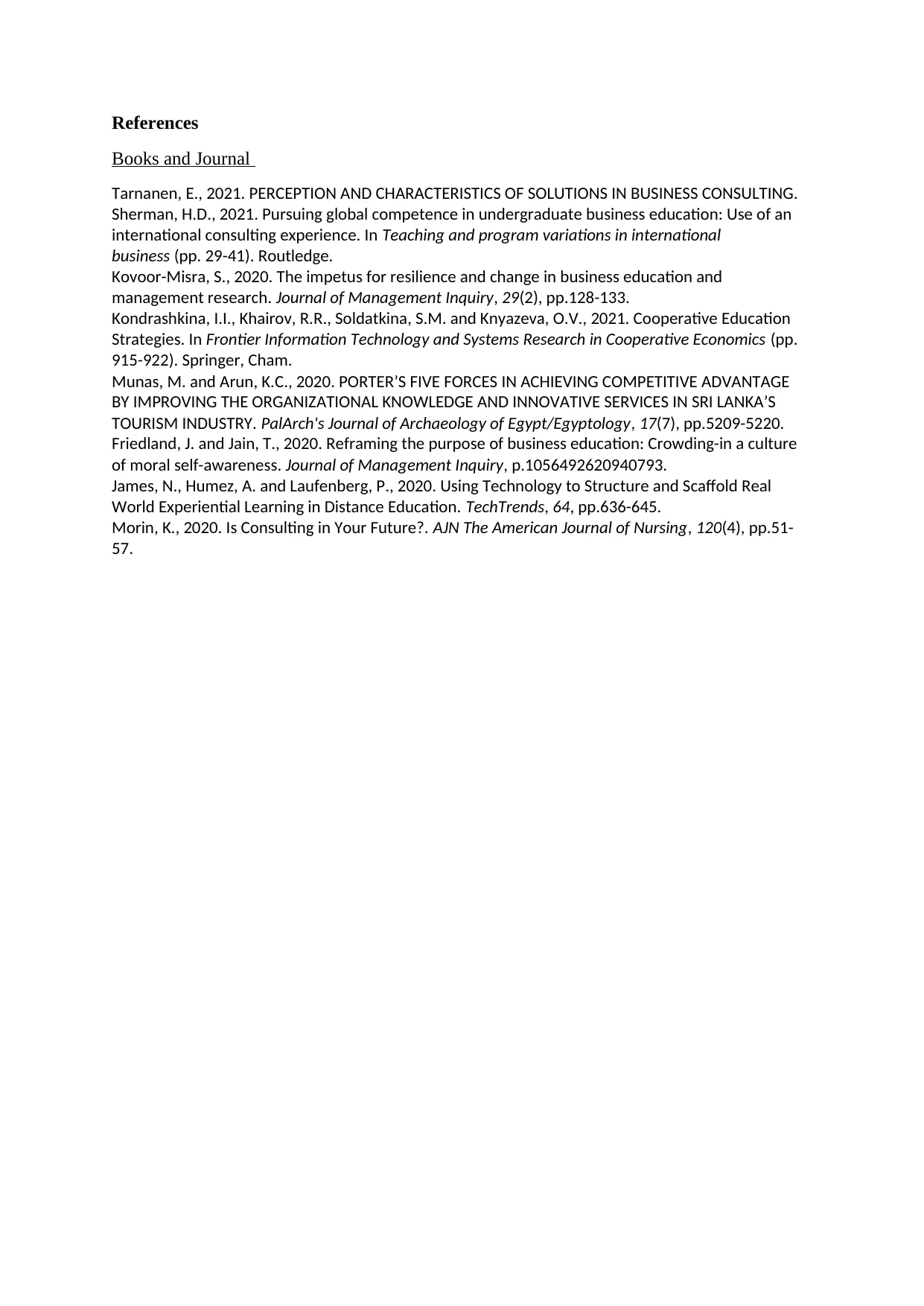
References
Books and Journal
Tarnanen, E., 2021. PERCEPTION AND CHARACTERISTICS OF SOLUTIONS IN BUSINESS CONSULTING.
Sherman, H.D., 2021. Pursuing global competence in undergraduate business education: Use of an
international consulting experience. In Teaching and program variations in international
business (pp. 29-41). Routledge.
Kovoor-Misra, S., 2020. The impetus for resilience and change in business education and
management research. Journal of Management Inquiry, 29(2), pp.128-133.
Kondrashkina, I.I., Khairov, R.R., Soldatkina, S.M. and Knyazeva, O.V., 2021. Cooperative Education
Strategies. In Frontier Information Technology and Systems Research in Cooperative Economics (pp.
915-922). Springer, Cham.
Munas, M. and Arun, K.C., 2020. PORTER’S FIVE FORCES IN ACHIEVING COMPETITIVE ADVANTAGE
BY IMPROVING THE ORGANIZATIONAL KNOWLEDGE AND INNOVATIVE SERVICES IN SRI LANKA’S
TOURISM INDUSTRY. PalArch's Journal of Archaeology of Egypt/Egyptology, 17(7), pp.5209-5220.
Friedland, J. and Jain, T., 2020. Reframing the purpose of business education: Crowding-in a culture
of moral self-awareness. Journal of Management Inquiry, p.1056492620940793.
James, N., Humez, A. and Laufenberg, P., 2020. Using Technology to Structure and Scaffold Real
World Experiential Learning in Distance Education. TechTrends, 64, pp.636-645.
Morin, K., 2020. Is Consulting in Your Future?. AJN The American Journal of Nursing, 120(4), pp.51-
57.
Books and Journal
Tarnanen, E., 2021. PERCEPTION AND CHARACTERISTICS OF SOLUTIONS IN BUSINESS CONSULTING.
Sherman, H.D., 2021. Pursuing global competence in undergraduate business education: Use of an
international consulting experience. In Teaching and program variations in international
business (pp. 29-41). Routledge.
Kovoor-Misra, S., 2020. The impetus for resilience and change in business education and
management research. Journal of Management Inquiry, 29(2), pp.128-133.
Kondrashkina, I.I., Khairov, R.R., Soldatkina, S.M. and Knyazeva, O.V., 2021. Cooperative Education
Strategies. In Frontier Information Technology and Systems Research in Cooperative Economics (pp.
915-922). Springer, Cham.
Munas, M. and Arun, K.C., 2020. PORTER’S FIVE FORCES IN ACHIEVING COMPETITIVE ADVANTAGE
BY IMPROVING THE ORGANIZATIONAL KNOWLEDGE AND INNOVATIVE SERVICES IN SRI LANKA’S
TOURISM INDUSTRY. PalArch's Journal of Archaeology of Egypt/Egyptology, 17(7), pp.5209-5220.
Friedland, J. and Jain, T., 2020. Reframing the purpose of business education: Crowding-in a culture
of moral self-awareness. Journal of Management Inquiry, p.1056492620940793.
James, N., Humez, A. and Laufenberg, P., 2020. Using Technology to Structure and Scaffold Real
World Experiential Learning in Distance Education. TechTrends, 64, pp.636-645.
Morin, K., 2020. Is Consulting in Your Future?. AJN The American Journal of Nursing, 120(4), pp.51-
57.
1 out of 10
Related Documents
Your All-in-One AI-Powered Toolkit for Academic Success.
+13062052269
info@desklib.com
Available 24*7 on WhatsApp / Email
![[object Object]](/_next/static/media/star-bottom.7253800d.svg)
Unlock your academic potential
Copyright © 2020–2025 A2Z Services. All Rights Reserved. Developed and managed by ZUCOL.





